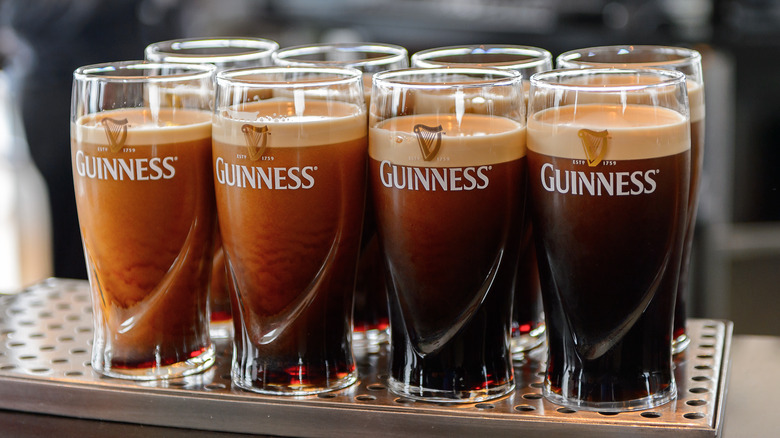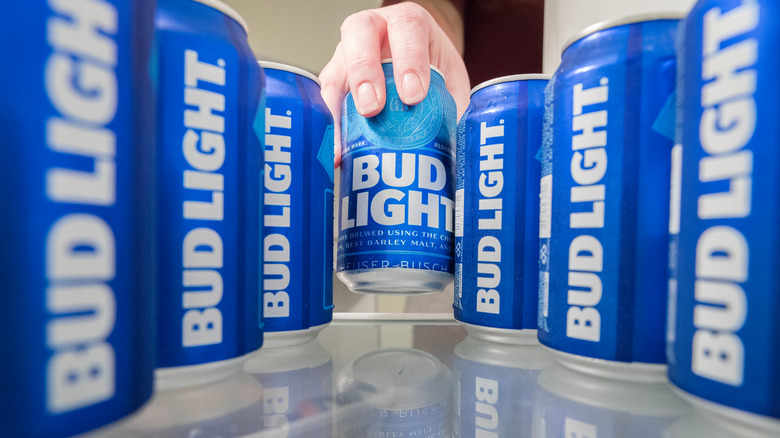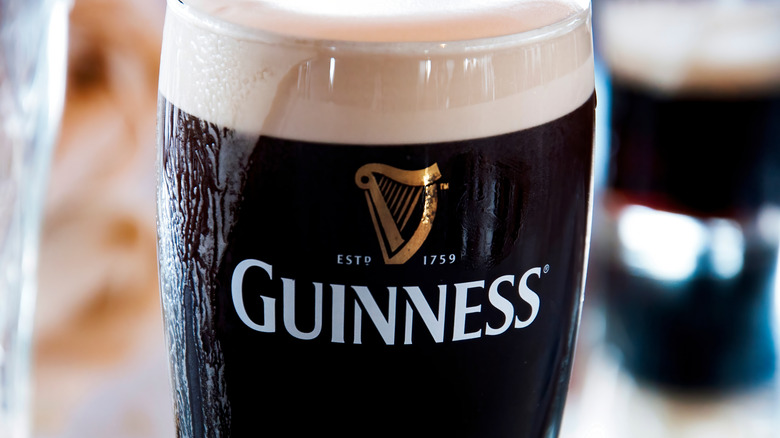Does A Guinness Really Have As Many Calories As Bud Light?
There are a lot of reasons to love Guinness: One is that it's absolutely delicious on draught, so much so that its loyalists are willing to wait the requisite two minutes for it to be optimally poured. Another is that its brewers actually brought in academic specialists to make the dark and foamy Irish stout taste even more amazing than it already did. Famously, these included two Oxford trained scientists, and a Cambridge educated mathematician. Tradition, of course, is another selling point for the brand — it's been around since 1759, after all.
One of the most underrated reasons to love Guinness, however, is its surprising calorie count. Despite its dark color, Guinness contains only 125 calories per 12 ounces. Even if you're drinking it in an Imperial 20 ounce pint glass — preferably in its ancestral home of Dublin, Ireland, of course — it has but 210 calories.
That places it well below many other popular beers in terms of calories, including ones significantly lighter in both body and color. A single 12 ounce serving of Guinness draught, in fact, has fewer calories than Budweiser (145), Coors (147), Corona Extra (148), Heineken (142), and Sam Adams Boston Lager (175).
Shockingly, it has only 15 more calories than Bud Light (110), a beer noted for its nutritional profile. Bud Light's calorie count and paucity of carbohydrates and protein once inspired The Washington Post to playfully describe it as "practically a health food."
Comparing the nutritional profiles of Bud Light and Guinness
Anyone adequately steeped in Guinness lore knows the beer was once prescribed or at least advocated by doctors to pregnant women in Ireland, due to its relatively high iron content (0.3 milligrams per pint). That's not the case anymore, of course. Nowadays, the U.K.'s National Health Service advises women not to drink alcohol at all during pregnancy. However, given Guinness' modest calorie count, it's worth noting that its nutritional values fare very well when compared to Bud Light.
Both beers are 4.2% alcohol by volume, a fact which helps to explain why their calorie counts are so similar. Beer, of course, gets most of its calories from alcohol. Guinness, for instance, sources 78 of its 125 calories solely from alcohol. It's true that Guinness draught has a few more carbs than Bud Light (10 grams versus 6.6), to go along with its 15 more calories per serving. But both have zero fat, and in terms of real health benefits, it isn't even close. Guinness draught is in a class all by itself.
No, we're not talking about Guinness' notable levels of fiber and folate, which are better than most beers. We're talking about a health benefit that places Guinness closer to red wine than light lagers.
Where Guinness stands alone
Guinness is famous for its 1929 advertising campaign claiming "Guinness is Good for You." Only in recent decades has this once-popular marketing slogan has proven to be true. As The Drinks Business reported, a 2003 study involving dogs at the University of Wisconsin showed that Guinness contained the same sort of antioxidant flavonoids associated with red wine and chocolate.
This study also suggested that drinking the iconic Irish stout actually lowers the risk of heart attacks caused by blood clots. Notably, dogs given lager — the light beer style shared by Heineken (the beer used in the study) and Bud Light — did not receive this benefit.
The ideal amount of Guinness that must be consumed to receive these heart-healthy benefits was given as 24 ounces, or two servings worth. Moderation, of course, is a critical factor in accruing any of the positive benefits linked to beer or wine.
Guinness' flavonoid qualities, which are similar to red wine and chocolate, are thought to be limited to dark beers. In fact, as Tuggeranong Square Medical Practice points out, these heart healthy qualities increase in relation to a beer's color, with darker being better. It's a pretty amazing benefit when you think about it, especially for a beer with only 125 calories.



